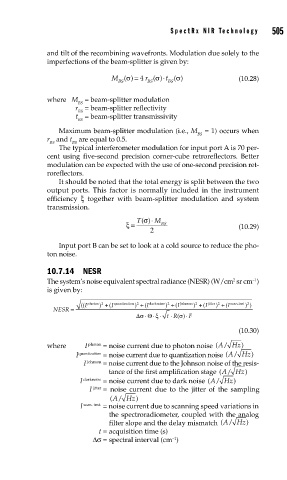Page 552 - Sensors and Control Systems in Manufacturing
P. 552
SpectRx NIR Technology
and tilt of the recombining wavefronts. Modulation due solely to the 505
imperfections of the beam-splitter is given by:
σ
σ
σ
M () = 4 r ()⋅ t () (10.28)
BS BS BS
where M = beam-splitter modulation
BS
r = beam-splitter reflectivity
BS
t = beam-splitter transmissivity
BS
Maximum beam-splitter modulation (i.e., M BS = 1) occurs when
r and t are equal to 0.5.
BS BS
The typical interferometer modulation for input port A is 70 per-
cent using five-second precision corner-cube retroreflectors. Better
modulation can be expected with the use of one-second precision ret-
roreflectors.
It should be noted that the total energy is split between the two
output ports. This factor is normally included in the instrument
efficiency ξ together with beam-splitter modulation and system
transmission.
σ ⋅ M
ξ = T() BS (10.29)
2
Input port B can be set to look at a cold source to reduce the pho-
ton noise.
10.7.14 NESR
2
The system’s noise equivalent spectral radiance (NESR) (W/cm sr cm )
–1
is given by:
)
)
) + (I
(( I photon 2 + I ( quantization 2 + I ( darknoise 2 Johnson 2 + (I jitter 2 + (I scan.inst 2
) )
)
)
NESR =
Δσ ⋅ Θ ξ ⋅ F
⋅ ⋅ t ⋅ R()σ
(10.30)
where I photon = noise current due to photon noise (/A Hz )
I quantization = noise current due to quantization noise (/A Hz )
I Johnson = noise current due to the Johnson noise of the resis-
tance of the first amplification stage (/A Hz )
I darknoise = noise current due to dark noise (/A Hz )
I jitter = noise current due to the jitter of the sampling
A
(/ Hz )
I scan. inst. = noise current due to scanning speed variations in
the spectroradiometer, coupled with the analog
filter slope and the delay mismatch (/A Hz )
t = acquisition time (s)
–1
Δσ = spectral interval (cm )

